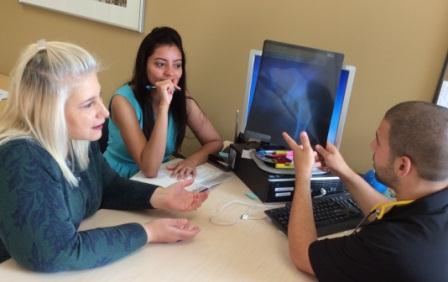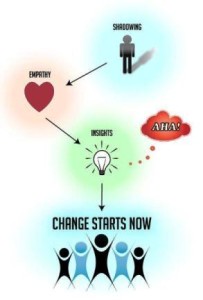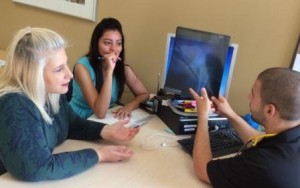
Creating a culture in which patient-centered care is embraced as the standard of care is no small challenge. However, what better way for future healthcare professionals to start their careers than to have a way in which to view every component of patient and family care experiences through their eyes. This is one of the reasons we take student training very seriously here in the PFCC Innovation Center of UPMC.
A Catalyst for Change
 On an ongoing basis, we train in the PFCC Methodology and Practice (PFCC M/P) which is a six-step approach to engaging patients and families as full partners in co-designing ideal care delivery. This methodology uses Shadowing – real-time, direct observation of every segment of the patient and family healthcare journey. It’s a unique and powerful tool that allows every single care provider to view care as an experience through the eyes of patients and families. Then cross-functional, high performance teams of care providers, called PFCC Working Groups, close the gaps between the current state identified through Shadowing, and the ideal. The power of real-time observation1 in identifying the current state lies in the emotional connection it creates for the observer which leads to insights — the “ah-ha” moment that creates an urgency to drive change.
On an ongoing basis, we train in the PFCC Methodology and Practice (PFCC M/P) which is a six-step approach to engaging patients and families as full partners in co-designing ideal care delivery. This methodology uses Shadowing – real-time, direct observation of every segment of the patient and family healthcare journey. It’s a unique and powerful tool that allows every single care provider to view care as an experience through the eyes of patients and families. Then cross-functional, high performance teams of care providers, called PFCC Working Groups, close the gaps between the current state identified through Shadowing, and the ideal. The power of real-time observation1 in identifying the current state lies in the emotional connection it creates for the observer which leads to insights — the “ah-ha” moment that creates an urgency to drive change.
1Tim Brown, Change by Design: How Design Thinking Transforms Organizations and Inspires Innovation
An Army of Shadowers
From our beginning, in 2006, we have encouraged the use of students as Shadowers. Not only can students conduct Shadowing at little to no cost to your organization, direct observation changes their own understanding of care delivery in a way that informs their work ever after. Here at the University of Pittsburgh Medical Center, we have used students preparing to embark on careers in medicine, nursing, pharmacy, and the allied health professions, as well as graduate students in Health Policy, Health Administration, and doctoral students in Nursing Practice (many of whom have gone on to implement Shadowing in their own organizations), as our army of Shadowers. And we’ve trained students preparing for non-healthcare careers from neighboring colleges and universities (some of which have even formed Shadowing Clubs).
 We also hire full-time student interns each summer. A great deal of their time with us is spent Shadowing care experiences across the healthcare system, creating associated Care Experience Flow Maps, and reporting their findings to PFCC Working Groups – bringing the sense of urgency about the current state, and opportunities to improve it, to the larger working groups.
We also hire full-time student interns each summer. A great deal of their time with us is spent Shadowing care experiences across the healthcare system, creating associated Care Experience Flow Maps, and reporting their findings to PFCC Working Groups – bringing the sense of urgency about the current state, and opportunities to improve it, to the larger working groups.
This summer, two of our full-time student interns wrote the following about their time spent learning the PFCC M/P and serving as Shadowers:
“As students soon entering medical school, we thought we had seen every side of health care. We were proven wrong after working as summer interns at the PFCC Innovation Center of UPMC. Shadowing has allowed us to view health care not from the typical care giver’s perspective as we are used to, but from the patient and family’s perspective. Being able to Shadow the caregiving experience from both the caregiver and the patient perspective is a unique dichotomy that we are privileged to have experienced. We Shadowed patients through a wide array of care experiences, including orthopedic surgery, internal medicine, transplant surgery, and obstetrics. Each care experience provided us with unique insights into not only these medical specialties but the processes by which care is delivered. And, no matter what care experience, the power of the PFCC M/P was always clear – viewing healthcare through the eyes of patients and families shows us ways to improve experiences and helps care givers understand how to engage patients to play a vital role in improving their health. In the face of a rapidly evolving health care industry, this insight into patient-centric care will be essential to our success in our future medical pursuits. We have been lucky to spend the summer at the PFCC Innovation Center and will undoubtedly utilize these lessons to aid our educational development as students and leaders in the healthcare field. Thank you to everyone who made this opportunity possible!”
As Will Rogers once said, “People’s minds are changed through observation and not through argument.” We encourage you to think about using students as Shadowers – setting them on a lifetime journey of observing healthcare as experiences and through the eyes of patients and families. If you’re interested in learning more about Shadowing, all of our training materials and guides are available for free download at www.pfcc.org.
For further insights about Shadowing and the PFCC Methodology and Practice, read last month’s PFCC Press newsletter and add your name to our mailing list to receive PFCC updates .




